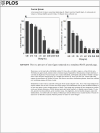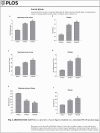Pistacia lentiscus L. revealed in vitro anti-proliferative activity on MCF-7 breast cancer cells and in vivo anti-mammary cancer effect on C57BL/6 mice through necrosis, anti-inflammatory and antioxidant enhancements
- PMID: 38635559
- PMCID: PMC11025873
- DOI: 10.1371/journal.pone.0301524
Pistacia lentiscus L. revealed in vitro anti-proliferative activity on MCF-7 breast cancer cells and in vivo anti-mammary cancer effect on C57BL/6 mice through necrosis, anti-inflammatory and antioxidant enhancements
Abstract
Inflammation and oxidative stress are two interconnected processes that play a role in cancer development and progression. In the present research, we aimed to evaluate the anticancer effect of Pistacia lentiscus L. (PL) essential oil (EO) in vitro against MCF-7 breast cancer cells and in vivo in DMBA-mammary cancer induction on female C57BL/6 mice model as well as to investigate its anti-inflammatory and antioxidant potential as implicated mechanism. Our results revealed a new chemotypes-profile of 39 bio-compounds of PL EO. The main chemotypes were terpenoid and ketone compounds. In vitro, PL EO had a potent anti-proliferative activity against MCF-7 cells. In vivo, PL reduced the tumor number, volume, weight and burden values as compared to the DMBA-positive control group (p<0.05). Histopathology data confirmed the protective effect of PL traduced by the presence of necrosis area. PL EO revealed improvement on inflammatory perturbation in the C-RP levels and the complete blood cell count. Finally, PL improved oxidative disorders of lipid peroxidation, thiol groups, hydrogen peroxide and antioxidant enzymes depletion in plasma and mammary tissues. Also, a potent plasma scavenging capacity has been detected. Our data suggested that PL chemotypes inhibited cell proliferation, exerting a potential protective effect against DMBA-mammary cancer through anti-inflammatory and antioxidant enhancements. Targeting inflammation and oxidative stress may represent a promising strategy for breast cancer prevention and treatment.
Copyright: © 2024 Abidi et al. This is an open access article distributed under the terms of the Creative Commons Attribution License, which permits unrestricted use, distribution, and reproduction in any medium, provided the original author and source are credited.
Conflict of interest statement
The authors declare that they have no conflicts of interest.
Figures





References
-
- Oms, W. H. O. World Health Organisation: Breast Cancer., Date. https://www.who.int/fr/news-room/fact-sheets/detail/breast-cancer
-
- Canadian Cancer Society, Breast cancer statistics. 2022.
-
- Mighri N., Mejri N., Boujemaa M., Berrazega Y., Rachdi H., El Benna H., et al.. Association between epidemiological and clinico-pathological features of breast cancer with prognosis, family history, Ki-67 proliferation index and survival in Tunisian breast cancer patients. PLoS One. 2022, 17, e0269732. doi: 10.1371/journal.pone.0269732 - DOI - PMC - PubMed
MeSH terms
Substances
LinkOut - more resources
Full Text Sources
Medical
Research Materials
Miscellaneous

